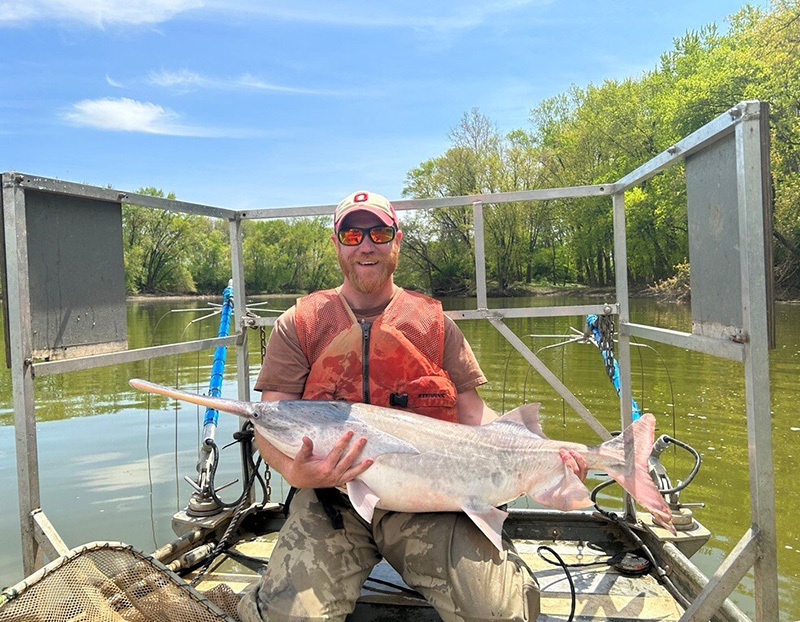The Paddlefish (Polyodon spathula) is a species of fish unlike any other freshwater fish in the world with its elongated, paddle like rostrum that is covered in electrosensory organs called ampullae of Lorenzini (Figure 1). The electrosensory organs are used to detect plankton, their primary food source. A pelagic species that inhabits deep pools, oxbows, and backwaters of large to major rivers with a plethora of plankton for food. Breeding occurs when water temperatures are from 50-60° F, photoperiod is appropriate, and over submerged gravel bars (Rice and Zimmerman 2019; Trautman 1981). Primarily inhabits of the Mississippi River, Missouri River, and Ohio River drainages, a few records exist in Lake Erie from the late 19th and early 20th century (Rice and Zimmerman 2019; Trautman 1981). Declines in numbers have been observed across its range, including complete extirpation from the Lake Erie drainage (Hubbs and Lagler 2004).

Figure 1. A Paddlefish (Polyodon spathula) collected in the Scioto River downstream of the Greenlawn Dam.
As a highly migratory species, dams installed for commerce in the Ohio and Mississippi Rivers, and for flood control or water storage in tributaries impedes reproduction by preventing access to spawning grounds and are the primary sources of population decline for the species. In Ohio, the Scioto River is the only system with a fair number of Paddlefish, though, their range is limited by the Greenlawn Dam (Figure 2). Records predating the 1950’s have individuals in the headwaters of Big Walnut Creek, near the mouth of the Olentangy River in the Scioto River, and near the mouth of the Mad River in the Great Miami River prior to the 1930’s (Trautman 1981). Other rivers that are potentially suitable for Paddlefish populations, such as the Muskingum River, also have impoundments. Dams on the Muskingum River at Devola, OH and the Great Miami River above Hamilton, OH removes any potential Paddlefish population from colonizing above those respective locations. Sparse numbers upstream of Portsmouth, OH in the Ohio River is potentially another reason for the lack of records in the Muskingum River below Devola, or sampling efforts have not coincided with when individuals are present. Which could also be the case in the Little Miami River.

Figure 2. The Greenlawn Dam located in downtown Columbus, OH is known to block upstream fish passage for species such as Paddlefish.
Rivers with low to moderate gradients that boast clean substrates, gravel bars and deep pools provide quality breeding and nursery habitat. Clean, coarse substrates are important for Paddlefish spawning. Fertilized eggs stick to gravel and cobble in flowing water until hatching occurs, where larvae float downstream into pools for further development (Rice and Zimmerman 2019). The first spawning event does not occur for males until the age of 4-5 years, while females do not mature until 7-10 years of age. Spawning events are also not annual as flows, temperature, and length of daylight all must align for breeding to occur.
Potentially a source of income for state regulatory agencies, Paddlefish are targeted by some anglers for meat due to their large size at adulthood and good amount of meat. Filets are boneless, and can be cut into steaks or smoked in preparation for consumption. Regulations for Paddlefish harvest have been implemented in states like Montana where a healthy population exists. The number of tags sold are limited each year to maintain the population, only one tag per individual is allowed each year, and dates are limited for harvest (MT FWP 2023). In Ohio, Paddlefish are protected and must be released when snagged due to their Threatened status.
Paddlefish have also become a desirable species to raise in captivity due to the dark coloration and flavor of their roe. Seen as a substitute for Sturgeon caviar since most Sturgeon species are threatened or endangered and sacrifice of the fish is required to make caviar. Paddlefish caviar can be milder in taste and less salty in taste, so it is preferred by some to traditional caviar (U of M 2007). Transitioning the caviar market to Paddlefish would allow for Sturgeon populations to rebound, and provide a sustainable source for the delicacy. It would also provide an opportunity of income for states and private individuals at low financial cost and minimal ecological cost.
Paddlefish are an intolerant species that requires free flowing rivers with clean substrates, deep pools, and a diverse flow regime to thrive. Historic pollution, installation of dams, and sedimentation of natural substrates have reduced Paddlefish populations across much of its native range. The recent move to removed old and outdated dams, improved water quality, and economic value of the species provides hope the species will be allowed to rebound in the future. Hopefully healthy populations will one day be observed in all major tributaries in Ohio to the Ohio River.
References
Hubbs, C.L. and Lagler, K.F. 2004. Fishes of the Great Lakes Region. The University of Michigan Press. Ann Arbor, MI. 276 pp. +
Montana Fish, Wildlife and Parks (MT FWP). Accessed May 24, 2023. Paddlefish Regulations. https://fwp.mt.gov/fish/regulations/paddlefish
Rice, D. and Zimmerman, B. A Naturalist’s Field Guide to the Fishes of Ohio. Special Publicatoin of the Ohio Biological Survey. Vii 391 pp.+
Trautman, M.B. 1981. The Fishes of Ohio. The Ohio State University Press. Columbus, OH. 782 pp.
University of Missouri (U of M). 2007. Paddlefish Production: Opportunities for Missouri Pond and Lake Owners. University of Missouri. Columbia, MO. 4 pp.

